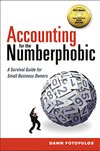
Accounting for the Numberphobic: A Survival Guide for Small Business Owners

However, if the value of the inventory decreases because selling prices are soft or because the prospects for its sale have significantly diminished, then the balance sheet must reflect this deteriorated value. This could also occur if the cost to replace the commodity has decreased below the price originally paid. In this case, where market value
... See moreDawn Fotopulos • Accounting for the Numberphobic: A Survival Guide for Small Business Owners
Notice that the first year’s depreciation expense is double the amount that it would have been using the straight-line method. Also, when the annual expense becomes less than what it would have been under the straight-line method, the depreciation expense reverts to straight-line for the remaining years. Some companies use this method for tax
... See moreDawn Fotopulos • Accounting for the Numberphobic: A Survival Guide for Small Business Owners
The portion of the total profits of the company that the owners have reinvested in the business during its entire history is called retained earnings. The retained earnings on the company’s balance sheet is the cumulative net income that the company has achieved throughout its entire history minus the cash dividends that the company has paid to its
... See moreDawn Fotopulos • Accounting for the Numberphobic: A Survival Guide for Small Business Owners
- Investments (and Intangible Assets), $59,000 There are a number of possible components of these two categories. These include: Ownership of other companies Partial equity stakes in other companies, including joint ventures Patents Trademarks Copyrights Goodwill This information is also presented at the lower of cost or market. If the market value
Dawn Fotopulos • Accounting for the Numberphobic: A Survival Guide for Small Business Owners
The figure given for inventory is the amount it cost the company to buy raw materials and components and to produce the product. The amounts presented are based on the accounting principle lower of cost or market. If the economic value of the inventory improves because of selling price increases or improvement in other market conditions, or because
... See moreDawn Fotopulos • Accounting for the Numberphobic: A Survival Guide for Small Business Owners
- If a company’s short-term debt keeps expanding, but its inventory and accounts receivable grow even faster, it is using banks to compensate for poor working capital management. Eventually, the banks will stop management from continuing this practice by threatening to call or actually calling the loan (demanding repayment), which they can do on very
Dawn Fotopulos • Accounting for the Numberphobic: A Survival Guide for Small Business Owners
The accounting process necessary to reflect this latter condition is called a writedown. The company would be required to write down the value of the inventory to reflect the reduced value.
Dawn Fotopulos • Accounting for the Numberphobic: A Survival Guide for Small Business Owners
Mathematical formulas called ratios are very valuable in the analytical process. They should be used to compare the company’s performance against: Its standards of performance (budget) Its past history (trends) The performance of other companies in a similar business (benchmarking)
Dawn Fotopulos • Accounting for the Numberphobic: A Survival Guide for Small Business Owners
An expenditure is the disbursement of cash or a commitment to disburse cash—hence the phrase capital expenditure. An expense is the recognition of the expenditure and its recording for accounting purposes in the time period(s) that benefited from it (i.e., the period in which it helped the company achieve revenue). The GAAP concept that governs
... See more